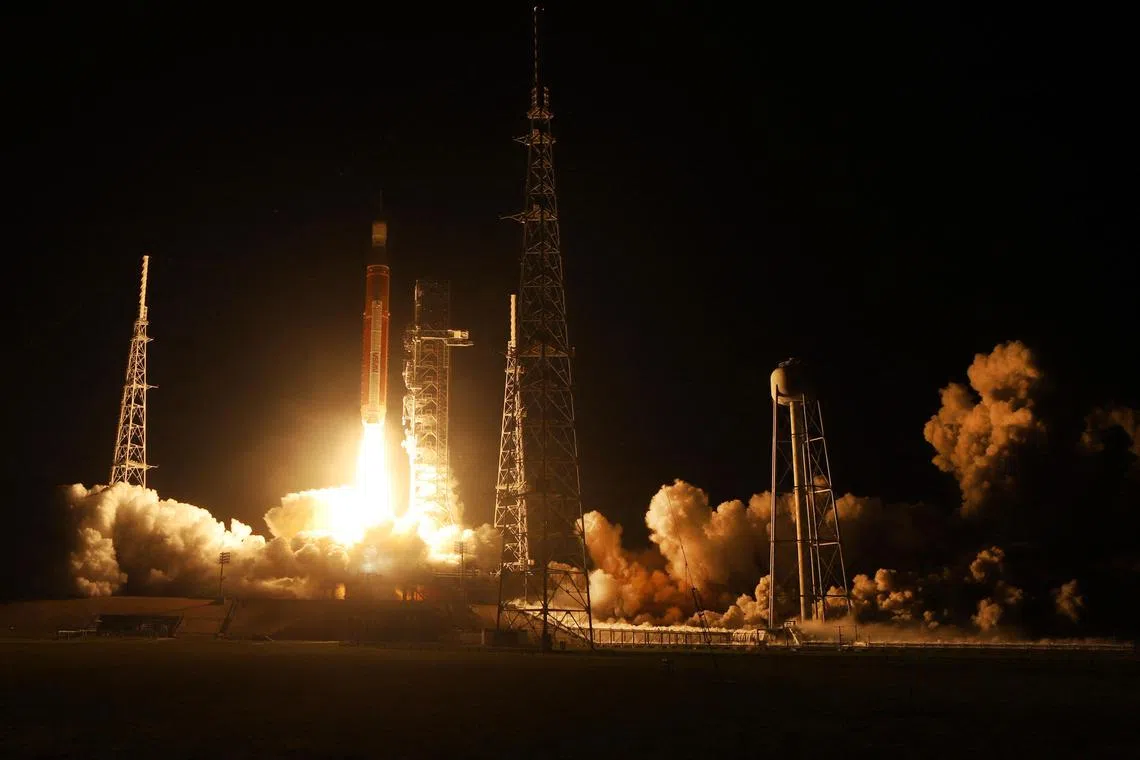Nasa’s Moon capsule Orion due to splash down after record-setting voyage
Sign up now: Get ST's newsletters delivered to your inbox

NASA's Artemis 1 SLS rocket, with the Orion capsule attached, launches at NASA's Kennedy Space Center, on Nov 16, 2022.
PHOTO: AFP
Follow topic:
Washington - The National Aeronautics and Space Administration’s (Nasa) uncrewed Orion capsule hurtled through space on Sunday on the final return leg of its voyage around the Moon and back.
This winds up the inaugural mission of the Artemis lunar programme 50 years to the day after Apollo’s final Moon landing.
As it hurtles into Earth’s atmosphere at a speed of 40,000kmh, the gumdrop-shaped traveller will have to withstand a temperature of 2,800 deg C – about half that of the surface of the Sun.
Splashdown in the Pacific off the Mexican island of Guadalupe is scheduled for 5.39pm GMT (1.39am on Monday, Singapore time).
Achieving success in this mission of just over 25 days is key for Nasa, which has invested tens of billions of dollars in the Artemis programme due to take people back to the Moon and prepare for an onward trip, someday, to Mars.
So far the first test of this uncrewed spacecraft has gone very well.
But it is only in the final minutes of this voyage that the true challenge comes: seeing if Orion’s heat shield, the biggest ever built, actually holds up.
“It is a safety-critical piece of equipment. It is designed to protect the spacecraft and the passengers, the astronauts on board.
“So the heat shield needs to work,” said Artemis mission manager Mike Sarafin.
A first test of the capsule was carried out in 2014 but that time the capsule stayed in Earth’s orbit, so it came back into the atmosphere at a slower speed of around 32,200kmh.
Choppers, divers and boats
A US Navy ship, the USS Portland, has been positioned in the Pacific to recover the Orion capsule in an exercise that Nasa has been rehearsing for years.
Helicopters and inflatable boats will also be deployed for this task.
The falling spacecraft will be slowed first by the Earth’s atmosphere and then a web of 11 parachutes until it eases to a speed of 30kmh when it finally hits the blue waters of the Pacific.
Once it is there, Nasa will let Orion float for two hours – a lot longer than if astronauts were inside – to collect data.
“We’ll see how the heat soaks back into the crew module and how that affects the temperature inside,” said Mr Jim Geffre, Nasa’s Orion vehicle integration manager.
Divers will then attach cables to Orion to hoist it onto the USS Portland, which is an amphibious transport dock vessel, the rear of which will be partly submerged.
This water will be pumped out slowly so the spacecraft can rest on a platform designed to hold it.

An undated photo provided by NASA of Earth, photographed from the Orion space capsule.
PHOTO: NYTIMES
This should all take about four to six hours from the time the vessel first splashes down.
The Navy ship will then head for San Diego, California, where the spacecraft will be unloaded a few days later.
When it returns to Earth, the spacecraft would have travelled 2.25 million km since it took off Nov 16 with the help of a monstrous rocket called SLS.
At its nearest point to the Moon it flew less than 130km from the surface. And it broke the distance record for a habitable capsule, venturing 432,000km from our planet.
Artemis 2 and 3
Recovering the spacecraft will allow Nasa to gather data that is crucial for future missions.
This includes information on the condition of the vessel after its flight, data from monitors that measure acceleration and vibration, and the performance of a special vest put on a mannequin in the capsule to test how to protect people from radiation while flying through space.
Some components of the capsule should be good for reuse in the Artemis 2 mission, which is already in advanced stages of planning.
This next mission planned for 2024 will take a crew towards the Moon but still without landing on it.
Nasa is expected to name the astronauts selected for this trip soon.
Artemis 3, scheduled for 2025, will see a spacecraft land for the first time on the south pole of the Moon, which features water in the form of ice.
Only 12 people – all of them white men – have set foot on the Moon. They did this during the Apollo missions, the last of which was in 1972.
Artemis is scheduled to send a woman and a person of colour to the Moon for the first time.
Nasa’s goal is to establish a lasting human presence on the Moon, through a base on its surface and a space station circling around it.
Having people learn to live on the Moon should help engineers develop technologies for a years-long trip to Mars, maybe in the late 2030s.
AFP, REUTERS

